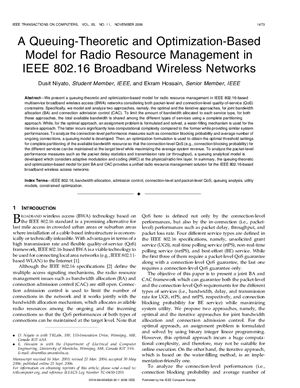IEEE Transactions on Computers, vol. 55, No. 11, November 2006, pp.
1473-1488.
Authors present a queuing-theoretic and optimization-based model for radio resource management in IEEE 802.16-based multiservice broadband wireless access (BWA) networks considering both packet-level and connection-level quality-of-service (QoS) constraints. Specifically, model and analyze two approaches, namely, the optimal and the iterative approaches, for joint bandwidth allocation (BA) and connection admission control (CAC) are considered. To limit the amount of bandwidth allocated to each service type, for both these approaches, the total available bandwidth is shared among the different types of services using a complete partitioning approach. While, for the optimal approach, an assignment problem is formulated and solved, a water-filling mechanism is used for the iterative approach. The latter incurs significantly less computational complexity compared to the former while providing similar system performances. To analyze the connection-level performance measures such as connection blocking probability and average number of ongoing connections, a queuing model is developed. Then, an optimization formulation is used to obtain the optimal threshold settings for complete partitioning of the available bandwidth resource so that the connection-level QoS (e.g., connection blocking probability) for the different services can be maintained at the target level while maximizing the average system revenue. To analyze the packet-level performance measures such as the packet delay statistics and transmission rate (or throughput), a queuing analytical model is developed which considers adaptive modulation and coding (AMC) at the physical/radio link layer. In summary, the queuing-theoretic and optimization-based model for joint BA and CAC provides a unified radio resource management solution for the IEEE 802.16-based broadband wireless access networks.
Authors present a queuing-theoretic and optimization-based model for radio resource management in IEEE 802.16-based multiservice broadband wireless access (BWA) networks considering both packet-level and connection-level quality-of-service (QoS) constraints. Specifically, model and analyze two approaches, namely, the optimal and the iterative approaches, for joint bandwidth allocation (BA) and connection admission control (CAC) are considered. To limit the amount of bandwidth allocated to each service type, for both these approaches, the total available bandwidth is shared among the different types of services using a complete partitioning approach. While, for the optimal approach, an assignment problem is formulated and solved, a water-filling mechanism is used for the iterative approach. The latter incurs significantly less computational complexity compared to the former while providing similar system performances. To analyze the connection-level performance measures such as connection blocking probability and average number of ongoing connections, a queuing model is developed. Then, an optimization formulation is used to obtain the optimal threshold settings for complete partitioning of the available bandwidth resource so that the connection-level QoS (e.g., connection blocking probability) for the different services can be maintained at the target level while maximizing the average system revenue. To analyze the packet-level performance measures such as the packet delay statistics and transmission rate (or throughput), a queuing analytical model is developed which considers adaptive modulation and coding (AMC) at the physical/radio link layer. In summary, the queuing-theoretic and optimization-based model for joint BA and CAC provides a unified radio resource management solution for the IEEE 802.16-based broadband wireless access networks.

